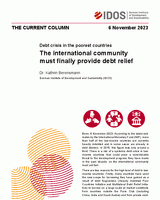Debt crisis in the poorest countries
The international community must finally provide debt relief
Berensmann, KathrinThe Current Column (2023)
Bonn: German Institute of Development and Sustainability (IDOS), The Current Column of 6 November 2023
Bonn, 6 November 2023. According to the latest estimates by the International Monetary Fund (IMF), more than half of the low-income countries are currently heavily indebted and in some cases are already in debt distress. In 2015, this figure was only around a third. There is a risk of a systemic debt crisis in low-income countries that could pose a considerable threat to the development progress they have made in the past decade, so the international community must act fast.
There are two reasons for the high level of debt in low-income countries. Firstly, many countries have used the new scope for borrowing they have gained as a result of debt forgiveness (Heavily Indebted Poor Countries Initiative and Multilateral Debt Relief Initiative) to borrow on a large scale at market conditions from countries outside the Paris Club (including China, India and Saudi Arabia) and from private creditors. The Paris Club is an informal forum in which primarily Western official bilateral creditors conduct negotiations with heavily indebted countries on debt restructuring.
These market loans have been associated with high debt-servicing burdens. According to the World Bank, the share of public debt owed by low-income countries to official bilateral creditors that are not members of the Paris Club increased from 42 per cent in 2010 to 68 per cent in 2021; China’s share of this official bilateral debt stock grew from 18 per cent to 49 per cent. In 2022, around two thirds of official bilateral debt service payments went to China. The second reason is connected with the multiple crises that have occurred in recent years, particularly the COVID-19 pandemic and the war in Ukraine, which have changed the macro-economic environment and have led to high interest rates.
Both have resulted in higher debt-servicing costs. Increasingly scarce budget funds need to be spent on debt servicing, which means that they can no longer be used to help achieve the Sustainable Development Goals (SDGs) and the climate goals.
What solutions are available?
Heavily indebted low-income countries urgently need debt restructuring and many even need debt forgiveness. On the other hand, these kinds of measures would use up the limited official development assistance (ODA) funds for earlier programmes and projects. The financial resources for current and future investments in the SDGs and climate goals could then decrease significantly. Moreover, debt relief has the disadvantage that the vicious circle of debt relief, new scope for borrowing, high levels of debt and renewed debt relief continues.
So what is the answer? What restructuring instrument is available at short notice and is suitable in this context? The best solution would be to establish a sovereign insolvency procedure that could involve all creditors and offer a predictable and transparent legal framework for debt restructuring or debt relief. Although the German Federal Government advocates introducing an insolvency procedure, as outlined in the current Coalition Agreement, this is a complicated instrument that is difficult to legally enforce and is politically controversial at international level. This procedure cannot be realised in the short term.
In the acute situation, it would be more realistic to make use of existing instruments to provide debt relief for low-income countries, such as the G20 Common Framework for Debt Treatments. Unfortunately, as a result of coordination problems among the creditors and non-transparent debt agreements, only four countries have taken part in the Common Framework – Chad, Ethiopia, Ghana and Zambia – since it was introduced at the end of 2020. It therefore needs to be reformed as follows:
Firstly, the G20 and the international financial institutions should support creditor coordination and should build trust and maintain a dialogue with the large creditors such as China and India. To do so, the new Global Sovereign Debt Roundtable jointly led by the IMF, the World Bank and the G20 Presidency is a good initiative that includes both public and private creditors.
Secondly, not only bilateral but also multilateral and private creditors should be included. According to the World Bank, the external debt owed by low-income countries to multilateral creditors accounted for about 47 per cent in 2021.
Thirdly, debt restructuring should be linked to measures to combat climate change with a view to harnessing synergies. As climate change also poses risks for countries’ debt sustainability, the debt sustainability analyses conducted by the IMF and the World Bank should incorporate climate risks more comprehensively and should take account of the volume of investment in climate adaptation.
It is already clear that the world’s highly indebted poorest countries depend on debt relief. Otherwise, the development progress made over the past decade risks being reversed.

